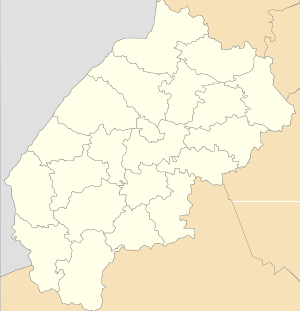Klymets
Klymets (Ukrainian: Климе́ць, Polish: Klimiec) — is a selo (village) in Skole Raion, Lviv Oblast, of western Ukraine. More specifically, it is located in the Ukrainian Carpathians, within the limits of the Eastern Beskids (Skole Beskids) in southwestern part of the Lviv Oblast in Skole Raion. It is situated 149 kilometres (93 mi) from the regional center Lviv, 40 kilometres (25 mi) from the district center Skole, and 113 kilometres (70 mi) from Uzhhorod.
Klymets Климець | |
|---|---|
.jpg) | |
 Klymets | |
| Coordinates: 48°50′19″N 23°10′41″E | |
| Country | |
| Province | |
| District | Skole Raion |
| Established | 1565 |
| Area | |
| • Total | 1,28 km2 (49 sq mi) |
| Elevation /(average value of) | 777 m (2,549 ft) |
| Population | |
| • Total | 342 |
| • Density | 267,19/km2 (69,200/sq mi) |
| Time zone | UTC+2 (EET) |
| • Summer (DST) | UTC+3 (EEST) |
| Postal code | 82650 |
| Area code | +380 3251 |
| Website | село Климець (Ukrainian) |
Local government — Klymetska village council.[1]
History
The first written record indicates that the date of foundation is considered to be 1565.[2]
There is other information: the village was established by German colonialists, which in Austrian times founded a colony Karlsdorf (German for Karl's village). The colony existed before the Second World War.[3]
Przemyśl Lands, including Skole District mercilessly suffered from attacks that have been from Tatar-Mongol invasion of Kievan Rus' at this time. The massive flight of peasants was observed at the beginning of the 18th century.
At the beginning of the 18th century, during the Austrian Empire (since 1867 Austria-Hungary), Skole District and other regions of the Austrian-held Carpathians began to colonize German craftsmen (see Galician Germans). This led to the development of industry and trade in land.
During the war, Klymets was situated at the border between Hungary and Ukraine. According to field research, approximately 12 Jews were murdered by the Germans in the summer of 1942.[4]
Notes
- Климецька сільська рада (in Ukrainian)
- (in Ukrainian)
- About the village Klymets (in Ukrainian)
- http://yahadmap.org/#village/klymets-lviv-ukraine.626